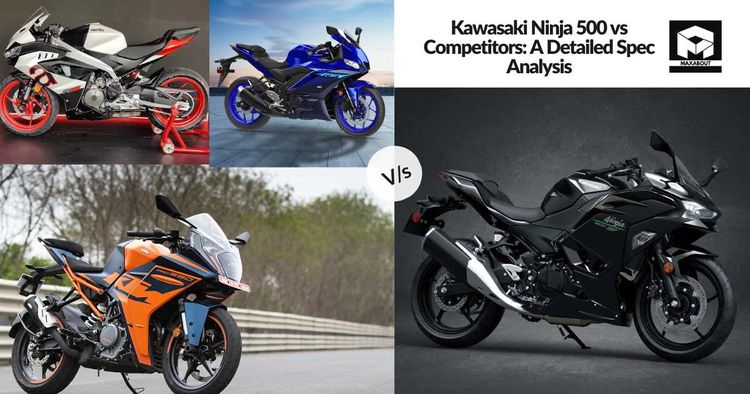The Kawasaki Ninja 500 has been launched in India at an introductory price of Rs 5.24 lakh (ex-showroom), matching the price of the outgoing Ninja 400. This new addition to the Ninja lineup comes to India as a Completely Built Unit (CBU), which contributes to its higher price tag. Let's see how it compares with its immediate rivals in terms of engine, output, weight, dimensions, suspension, brakes, features, and price.
Engine & Performance
The Kawasaki Ninja 500, Aprilia RS 457, Yamaha R3, and KTM RC 390 boast various engine specifications:
- Kawasaki Ninja 500: It features a liquid-cooled, 451cc, parallel-twin engine producing 45hp at 9,000rpm and 42.6Nm of torque at 6,000rpm.
- Aprilia RS 457: Equipped with a liquid-cooled, 457cc, parallel-twin engine, it delivers 47.6hp at 9,400rpm and 43.5Nm of torque at 6,700rpm.
- Yamaha R3: Its 321cc liquid-cooled parallel-twin engine produces 29.5 Nm of torque at 9,000 rpm and 42 horsepower at 10,750 rpm.
- KTM RC 390: Featuring a liquid-cooled, 373cc, single-cylinder engine, it offers 43.5hp at 9,000rpm and 37Nm of torque at 7,000rpm.
Although the Ninja 500 retains the same peak power as its predecessor it now boasts increased torque, enhancing its performance, especially at lower speeds. On the other hand, the Yamaha R3 exhibits the lowest torque among the bikes compared, reaching its peak output at higher engine speeds. Notably, the firing order of the Ninja 500 and Yamaha R3 is 180 degrees, common in small-capacity Japanese twin-cylinder engines. However, the Aprilia RS 457 stands out with its 270-degree firing order offering a distinctive exhaust note. Despite having one less cylinder, the KTM RC 390 manages to achieve a higher power-to-weight ratio than the smaller Yamaha.

Weight & Dimensions
- Kawasaki Ninja 500: It weighs 171kg, with a seat height of 785mm, a wheelbase of 1375mm, and a fuel capacity of 14 liters.
- Aprilia RS 457: Weighing 175kg, it features a seat height of 800mm, a wheelbase of 1360mm, and a fuel capacity of 13 liters.
- Yamaha R3: With a weight of 169kg, it has a seat height of 780mm, a wheelbase of 1380mm, and a fuel capacity of 14 liters.
- KTM RC 390: Weighing 172kg, it offers a seat height of 835mm, a wheelbase of 1347mm, and a fuel capacity of 13.7 liters.
The Yamaha R3 emerges as the lightest among the four, just under the 170-kilo mark, despite carrying the most fuel. Interestingly, despite a larger engine, the Ninja 500 weighs only 2 kg more than the R3. For riders seeking approachable machines, the Japanese bikes provide the lowest perches, although the Ninja 500 offers the least ground clearance among the group.
Suspension & Brakes
- Kawasaki Ninja 500: Utilizes a telescopic fork and a mono-shock, with 310mm disc brakes at the front and 220mm disc brakes at the rear.
- Aprilia RS 457: Features USD fork suspension and a mono-shock, equipped with 320mm disc brakes at the front and 220mm disc brakes at the rear.
- Yamaha R3: Comes with USD fork suspension, a mono-shock, and 298mm disc brakes at the front and 220mm disc brakes at the rear.
- KTM RC 390: Utilizes USD fork suspension, a mono-shock, with 320mm disc brakes at the front and 230mm disc brakes at the rear.
The Ninja 500 stands out with its telescopic fork suspension compared to the USD forks on the other bikes. However, except for the preload-adjustable fork on the Aprilia RS 457, the suspension on the other bikes is non-adjustable. Additionally, the Japanese bikes use axially mounted Nissin calipers for brakes, while the European bikes use radially mounted ByBre calipers. Although tyre sizes are similar, the tyre compounds differ, with the Japanese bikes using Dunlop tyres, while the RC and RS models come with Metzeler and TVS Eurogrip tyres, respectively.
Features
- Kawasaki Ninja 500: India's standard variant has an LCD dash with Bluetooth connectivity.
- Aprilia RS 457: Offers riding modes, traction control, and a TFT dash.
- Yamaha R3: Misses out on features like riding modes and traction control but offers a bidirectional quick-shifter.
- KTM RC 390: Features a bidirectional quick-shifter and the option to turn off ABS at the rear.
While the Ninja 500 offers Bluetooth connectivity, advanced features like riding modes and traction control are only available on the Aprilia RS 457. Notably, the RC 390 and RS 457 also feature a bidirectional quick-shifter, with the RC 390 offering it as standard and the RS 457 offering it as an optional extra.
Price
- Kawasaki Ninja 500: Priced at Rs 5.24 lakh (ex-showroom, India).
- Aprilia RS 457: Priced at Rs 4.10 lakh (ex-showroom, India).
- Yamaha R3: Priced at Rs 4.65 lakh (ex-showroom, India).
- KTM RC 390: Priced at Rs 3.18 lakh (ex-showroom, India).
Due to being imported via the CBU route, the Ninja 500 and Yamaha R3 are priced higher compared to the locally manufactured KTM and Aprilia models. With the Aprilia offering a twin-cylinder experience at a more affordable price, consumer preference between the Japanese and European offerings remains to be seen.

